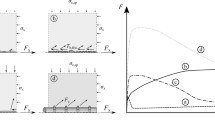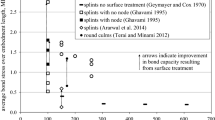Abstract
The main objective of the extensive research programme involving 238 test specimens was to provide bond strength criteria between type 2 deformed bars and concrete in models for predicting early-age rracking. The major variables included bar diameter, concrete cover, age of concrete, transverse reinforcement and anchorage length. Both the pull-out load and slip displacement were determined using specially developed tensile bond tests where both steel and concrete were in tension. The bond strength of deformed bars showed a significant age effect and design equations suitable for toth ultimate and serviceability limit states at early age have been developed. BS 8110 and BS 8007 Code values underestimated the ultimate bond strength for the concrete strengths considered, while the same values from BS 8110 and BS 8007 overestimated or compared approximately with, respectively, the average bond stress test results at 0.1 mm slip. AC1-318 Building Code, on the other hand, overestimated the bond strength for concrete cube strengths up to 15 MPa and then became conservative.
Resume
On a réalisé un vaste programme de recherche sur 238 éprouvettes, dont l'objectif principal était d'obtenir des critères d'adhérence entre des barres déformées de type 2 et le béton dans des modèles permettant de prévoir la fissuration aux jeunes âges. Les principales variables étaient: le diamètre de la barre, l'enrobage du béton, son âge, le renforcement transversal et la longueur de l'ancrage. On a déterminé à la fois la charge d'arrachement et la longueur de glissement par des essais d'adhérence où l'acier comme le béton étaient soumis à la traction. On a constaté l'importance de l'âge des barres, et on a établi des équations variables à la fois pour les états limites ultimes et en service aux jeunes âges. Les valeurs de calcul données par BS 8110 et BS 8007 sous-estiment l'adhérence maximale pour les résistances du béton considérées, tandis que les mêmes valeurs extraites des mêmes documents surestimaient ou rejoignaient à peu près la moyenne des résultats d'essai de la contrainte d'adhérence pour un glissement de 0,1 mm. D'autre part, ACI-318 surestime l'adhérence pour des résistances sur cubes du béton allant jusqu'à 15 MPa, et, au-delà, devient normal.
Similar content being viewed by others
Abbreviations
- f cu :
-
Concrete cube strength
- f cy :
-
Concrete cylinder strength
- f*et :
-
Direct tensile strength of concrete
- f′ ct :
-
Indirect tensile strength of concrete (cylinder splitting strength)
- f b1 :
-
Average bond stress for 0.1 mm slip
- f b2 :
-
Average bond stress for 0.2 mm slip
- f bu :
-
Average bond strength at ultimate between steel and concrete
- f s1 :
-
Tensile stress in the steel reinforcement for 0.1 mm slip
- f s2 :
-
Tensile stress in the steel reinforcement for 0.2 mm slip
- ϕ:
-
Diameter of a reinforcing bar
- ρ c :
-
Steel ratio based on gross area of concrete
References
American Concrete Institute Comittee 408, ‘Bond stress. The state of the art’,ACI J. Proc.,63 (1966) 1161–1190.
Comité Euro-international du Béton, ‘Bond Action and Bond Behaviour of Reinforcement-State of the Art Report’, Bulletin D[Information No. 151 (1981) pp. 1–153.
RILEM Committee 42-CEA, ‘Properties of set concrete at early ages. State of the art report’,Mater. Struct.,14 (1981) 399–450.
Chapman, R. A. and Shah, S. P., ‘Early-age bond strength in reinforced concrete’,ACI Mater. J.,84 (1987) 501–510.
British Standards Institution, BS 8110:1985, ‘Structural Use of Concrete, Part 1. Code of Practice for Design and Construction’ (BSI, London, 1985).
British Standards Institution, BS 8007:1987, ‘Code of Practice for the Design of Concrete Structures for Retaining Aqueous Liquids’ (BSI, London, 1987).
American Concrete Institute Committee 318, ‘Building Code Requirements for Reinforced Concrete’, ACI Committee Report 318-83 (1983).
American Concrete Institute Committee 408, ‘Suggested development, splice and standard hook provisions for deformed bars in tension’,Concr. Internat.: Design Constr.,1(7) (1979) 44–46.
Kemp, E. L., ‘Bond in reinforced concrete: behavior and design criteria’,ACI J.,83(1) (1986) 50–57.
CEB-FIP Model Code for Concrete Structures, in ‘CEB-FIP International Recommendations’, Vol. 2, 3rd Edn (Comité Euro-International du Béton and Fédération Internationale de la Précontrainte, 1978, pp. 31–348.
Videla, C., ‘Efecto de la edad del hormigón en la resistencia de adherencia (Effect of concrete age on bond strength)’,Jornada Latinoamericana del Cemento y del Hormigón, VII Jornadas Chilenas del Hormigón (Instituto Profesional de Santiago, Chile),1 (1988) 204–218.
Instituto Nacional de Normalización, ‘Hormigón-Requisitos Genrales (Concrete-General Requirements)’, Norma NCh 170 Of. 85 (Instituto Nacional de Normalización, Santiago, 1985).
Hughes, B. P., ‘Limit State Theory for Reinforced Concrete Design, 3rd Edn (Pitman, London, 1980).
Orangun, C. O., Jirsa, J. O. and Breen, J. E., ‘A reevaluation of test data on development length and splices’,ACI J.,74(3) (1977) 114–122.
Jirsa, J. O., Lutz, L. A. and Gergely, P., ‘Rationale for suggested development, splice, and standard hook provisions for deformed bars in tension’,Concr. Internat.: Design Constr.,1 (7) (1979) 47–61.
Ghunaim, F., ‘Early Age thermal Cracking in Reinforced Concrete’, MSc thesis, University of Birmingham (1981).
Base, G. D., ‘Bond and control of cracking in reinforced concrete, bond in concrete’, in Proceedings of International Conference on Bond in Concrete, Department of Civil Engineering, Paisley College of Technology, Scotland, edited by P. Bartos (Applied Science, London, 1982) pp. 446–457.
Campbell-Allen, D. and Hughes, G. W., ‘Reinforcement to Control Thermal and Shrinkage Cracking’, Research Report No. R334 (University of Sydney School of Civil Engineering, 1978).
American Society for Testing and Materials, ‘Standard Test Method for Comparing Concretes on the Basis of the Bond Developed with Reinforcing Steel’, ASTM C234-71 (American Society for Testing and Materials, Philadelphia, 1977).
RILEM/CEB/FIP Committee, 1970. ‘Test and Specifications of Reinforcements for Reinforced and Prestressed Concrete. Four Recommendations of the RILEM/CEB/FIP Committee-Bond Test for Reinforcing Steel-1 Beam Test-2 Pull-Out Test’,Mater. Struct.,3(15) (1970) 169–178.
Videla, C., ‘Early-age Thermal Cracking and Bond in Reinforced Concrete’. PhD thesis, School of Civil Engineering, University of Birmingham (1989).
Plowman, J. M., ‘The measurement of bond strength’, in Proceedings of RILEM Symposium on Bond and Crack Formation in Reinforced Concrete, Stockholm, 1957, Vol. 1, Papers pp. 147–163.
Leonhardt, F. (1957). ‘On the need to consider the influence of lateral stresses on bond’,ibid. Proceedings of RILEM Symposium on Bond and Crack Formation in Reinforced Concrete, Stockholm, 1957, Vol. 1, Papers pp. 29–34.
Instituto Nacional de Normalización, ‘Acero: Barras Laminadas en Caliente para Hormigón Armado— Requisitos Generales (Steel: Hot Rolled Bars for the Reinforcement of Concrete)’, Norma NCh 204 Of. 78 (Instituto Nacional de Normalización, Santiago, 1978).
British Standards Institution, BS 449:1988, ‘Specification for Carbon Steel Bars for the Reinforcement of Concrete’ (BSI, London, 1988).
Eligehausen, R., Popov, E. V. and Bertero, V., ‘Local Bond Stress-Slip Relationships of Deformed Bars Under Generalized Excitations’, Report No. UCB/EERC-83/23 (Earthquake Engineering Research Center, University of California, Berkeley, 1983).
British Standards Institution, BS 18:1971, ‘Methods for Tensile Testing of Metals, Part 2: Steel (General) (BSI, London, 1971).
Idem, BS 1881:1970, ‘Methods of Testing Concrete, Part 2: Methods of Testing Fresh Concrete, Part 4: Methods of Testing Concrete for Strength and Amendment MAD 782 (BSI, London, 1971).
Author information
Authors and Affiliations
Rights and permissions
About this article
Cite this article
Hughes, B.P., Videla, C. Design criteria for early-age bond strength in reinforced concrete. Materials and Structures 25, 445–463 (1992). https://doi.org/10.1007/BF02472635
Issue Date:
DOI: https://doi.org/10.1007/BF02472635




